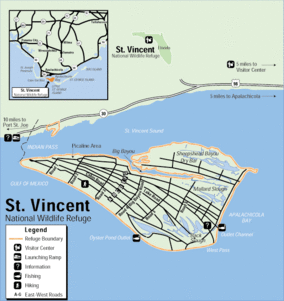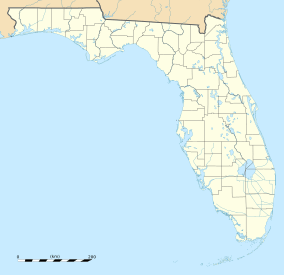St. Vincent National Wildlife Refuge facts for kids
Quick facts for kids St. Vincent National Wildlife Refuge |
|
|---|---|
|
IUCN Category V (Protected Landscape/Seascape)
|
|

Map of St. Vincent Island
|
|
| Location | Franklin and Gulf counties, Florida, United States |
| Nearest city | Apalachicola, Florida |
| Area | 12,490 acres (51 km2) |
| Established | 1968 |
| Governing body | US Fish & Wildlife Service |
| Website | St. Vincent National Wildlife Refuge |
The St. Vincent National Wildlife Refuge is a special protected area in northwestern Florida, United States. It is part of the National Wildlife Refuge System. This refuge is mostly on St. Vincent Island, a barrier island located off the coast near Apalachicola, Florida. The refuge also includes a small island called Pig Island and some land on the mainland of Florida.
The refuge was created in 1968 to protect wildlife and their homes. It covers about 12,490 acres, which is like 51 square kilometers. St. Vincent Island is very close to the mainland, just a short boat ride away.
Because you can only get there by boat, the refuge usually does not have many visitors. This helps keep the island wild and peaceful. Visitors can enjoy long walks on the beaches. They can also explore the island's inside areas, which have ten different types of natural habitats. The island has been kept almost untouched, even though it was once privately owned.
People have lived on St. Vincent Island for a very long time. Pottery pieces found there show that Native Americans lived on the island as far back as the year 240. The island has had many different owners over the years. In 1948, some interesting animals were brought to the island. These included zebras, sambar deer, elands, black bucks, ring-necked pheasants, Asian junglefowl, bobwhite quails, and wild turkeys.
In 1968, The Nature Conservancy bought the island. Later, the U.S. Fish and Wildlife Service bought it from them. They used money from Duck Stamp sales. This is how the St. Vincent National Wildlife Refuge was officially started.
Contents
Island Climate
The weather on St. Vincent Island is mild and subtropical. This means it's usually warm, like other places along the Gulf Coast. The island gets about 57 inches of rain each year.
Amazing Wildlife
Many different kinds of animals live on St. Vincent Island. You can see them depending on the time of year. Some of these animals are endangered or threatened, which means they need special protection.
Springtime Animals
In spring, many animals on the island start to nest and have babies. You might see ospreys building nests. Softshell turtles and wood ducks also reproduce then. Young bald eagles begin to fly during this time. Also, white-tailed deer bucks shed their antlers in the spring.
Summer Animals
Summer is when loggerhead sea turtles come to the beaches to lay their eggs. Female alligators also build nests in the marshes. Many bird species can be seen, like the wood stork, snowy plover, and American oystercatcher.
Fall and Winter Animals
Fall brings many migrating birds to the refuge. You can see lots of waterfowl, shorebirds, and songbirds. Sometimes, Peregrine falcons are spotted during this season. In winter, the number of waterfowl is highest. Bald eagles and great horned owls are busy nesting. White-tailed deer are also getting ready for their breeding season, called the rut, which happens in winter. Alligators, other reptiles, and many other animals live on the island all year long.
Helping Red Wolves
Since 1990, St. Vincent National Wildlife Refuge has played an important role in helping the endangered red wolf. The refuge is a special place where these wolves can breed. The red wolves are allowed to roam freely on the island. Once the baby wolves, called pups, are old enough to leave their mother, they are moved. The pups are taken to the Alligator River National Wildlife Refuge in North Carolina. This helps increase the number of red wolves in the wild.
Fun Activities
Even though you need a boat to get to St. Vincent Island, there are many fun things to do once you arrive.
Boating and Water Fun
The island is a popular spot for sea kayaking and boating. You can also enjoy fishing and birding along the shore.
Exploring the Island
Inside the island, there are over 90 miles of roads. These roads are open for hiking and biking. Not all roads are still used, but the main road, called B Road, is covered with oyster shells. This makes it easier to travel over the sandy ground.
Wildlife Viewing and Fishing
Watching wildlife is a popular activity. You can also fish in one of the four lakes on the island. These lakes are stocked with largemouth bass and bluegill. When you visit, it's important to follow "leave no trace" rules. This means you should take everything you bring with you when you leave.
Hunting on the Island
To help control the animal populations, special hunts are held each year. These hunts help manage the numbers of Sambar deer, White-tailed deer, feral hogs, and raccoons. Licenses for these hunts are chosen by a lottery system. The Florida Fish and Wildlife Commission manages these hunts. Three public hunts happen every year between November and January. The refuge is closed to other visitors during these hunting times.
Managing Wildfires
Fire is a natural part of the environment in North America. Before roads were built on St. Vincent Island, lightning would start fires. These fires could burn across the island's different habitats. Now, when lightning starts a fire, the refuge staff decides where to stop it. They use methods that protect the island's water systems. These methods might include using water, building special lines to stop the fire, or using a controlled fire to fight the wildfire.
The refuge staff also starts planned fires, called prescribed burns. They do this to copy what natural lightning fires would do. Prescribed fires help keep the island healthy. They reduce the amount of dry leaves and dead plants that could fuel a big wildfire. This helps prevent more damaging fires in the future.
How to Visit
The closest place to launch a boat to the island is at the end of Indian Pass Road (County Road 30B). This boat ramp is open to everyone. Indian Pass is about 22 miles west of Apalachicola. Boaters should be careful of winds, changing tides, currents, storms, and oyster beds. You can also find private boat services that will take you to the island. There are no fees to visit the island, except if you are participating in a hunt. All parts of the refuge are open to the public, except for a small area on the mainland called the '11 Mile Site'.
Images for kids
-
Wood stork in flight
-
Florida alligator
-
Endangered red wolf
-
Prescribed burn of pine habitat on the island












